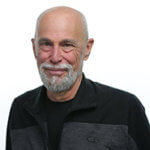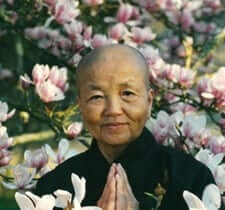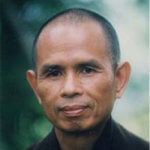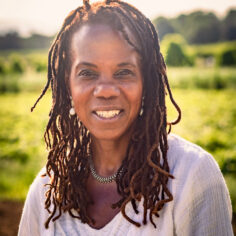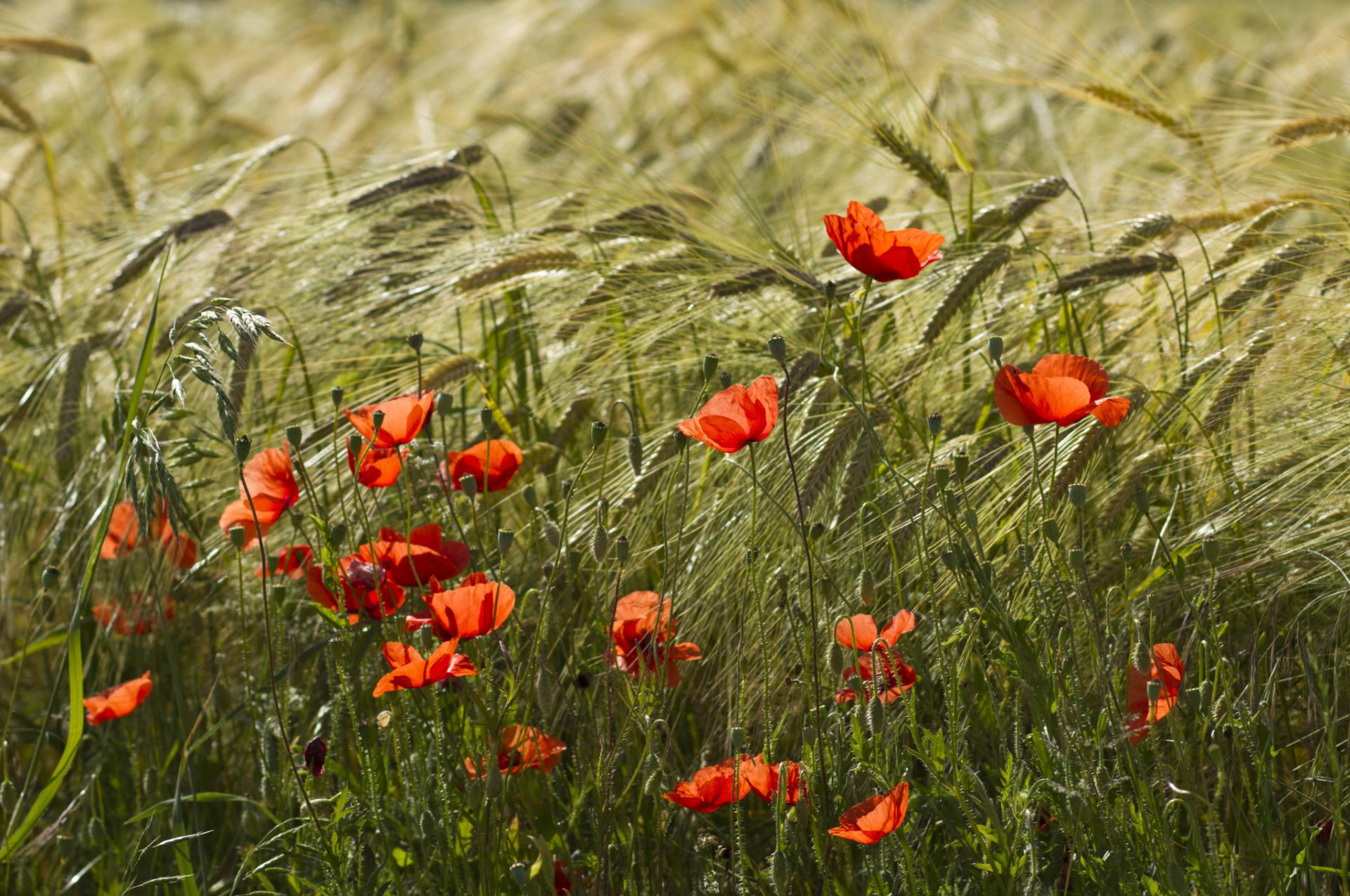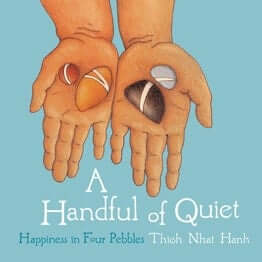
A Handful of Quiet
Happiness in our Pebbles
By Thich Nhat Hanh
Blossom Books, 2012
Hardcover, 62 pages
Reviewed by Elle Snow
Many years ago, on a meditation retreat in Santa Barbara, Thay and some children created Pebble Meditation. Like so many of Thay’s teachings, Pebble Meditation is both simple and profoundly deep.

A Handful of Quiet
Happiness in our Pebbles
By Thich Nhat Hanh
Blossom Books, 2012
Hardcover, 62 pages
Reviewed by Elle Snow
Many years ago, on a meditation retreat in Santa Barbara, Thay and some children created Pebble Meditation. Like so many of Thay’s teachings, Pebble Meditation is both simple and profoundly deep. The practice invites the child to hold a pebble, breathe in and out, and visualize an aspect of nature and what it represents as a life-giving state of being.
Breathing in I see myself as a flower
Breathing out I feel fresh.
Breathing in I see myself as a mountain
Breathing out I feel solid.
Breathing in I see myself as calm water
Breathing out I reflect what truly is.
Breathing in I see myself as space
Breathing out I feel free.
Pebble Meditation gives the left brain a tangible object for a child/practitioner to focus on (the pebble) as the right brain is opened to the abstraction of possibility. The whole brain is engaged as the pebble and the abstract are unified through touching what is evoked of the four elements in their symbolic representation of flower, water, mountain, and space. Through the “touchstone” of each aspect of nature, we can open ourselves to the transcendent wisdom of their correlates: fresh, clear, solid, and free.
A Handful of Quiet is a sweet book that has a great deal to offer children of all ages. In accessible language and with gentle illustration, it provides a way for a caring adult to introduce meditation, mindfulness, and nature to a child. It offers sixty pages of activities and tools in which to develop a relationship with Pebble Meditation. There is a section with practice pages where a child can name the moments when she has felt quiet or free. Also, Thay walks a child through a drawing activity. And there are steps for how to make a pebble meditation bag. Perhaps my favorite are the series of pages that begin with one, then two, then three, then four small blue watercolor splotches for the child to set his pebbles on as he does each step of the meditation.
Teaching a cherished child the skill of mindful awareness is one of the greatest gifts we can give. A Handful of Quiet is not only a lovely book; it is a way to engage a child though story, activity, and relationship. It is a bridge between a wise adult and an innocent child. It is a way to plant seeds through pebbles!
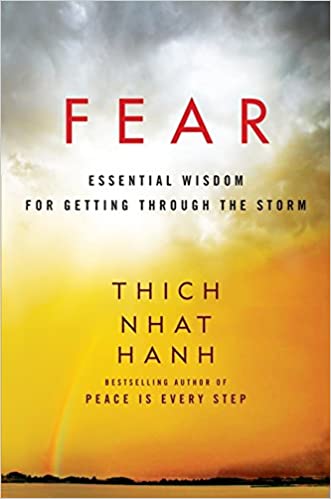
Fear
Essential Wisdom for Getting Through the Storm
By Thich Nhat Hanh
Harper One, 2012
Softcover, 156 pages
Reviewed by Judith Toy, True Door of Peace
It has been said that all of our negative emotions boil down to fear. So it’s no surprise that our beloved teacher has written a book that serves as an antidote to fear. As I write this review, just before the national elections on November 6, a fierce hurricane is slowly descending upon the East Coast of the U.S. The news media is shouting and magnifying our worst fears, and is even turning them into tools for political gain. This type of fear-mongering is actually a storm in itself, for it creates a culture of fear, which Thay teaches us, in this small but potent book, to counteract with mindful living.
The Buddha taught that while there is suffering, through mindfulness we can transform our suffering into peace, stability, and joy. In the Introduction, Thay discusses how we cannot make our fears go away by ignoring them, and that to bury our fears is to give them even more dominion over us. He offers specific methods for how to live fully in the here and now, so that we are no longer battered by the modern storm of fear and anxiety. In reading Thay’s book we learn that we can, indeed, transform the roots of fear from within.
Nowadays we often use shopping, alcohol, drugs, TV, films, books, and even conversations to distract ourselves from fear. By acting in this way, we unwittingly feed the storm. “If you stop running after the object of your craving,” writes the author, “—whether it’s a person, a thing or an idea—your fear will dissipate.” This notion reminds me of an old saying by the hippie philosopher Thaddeus Golas: “If you can’t find it where you are standing, where do you expect to wander in search of it?”
Thay points out that when we act out of fear, we actually foster a culture of fear, and that the antidote to this oppressive cycle is mindful living. He encourages us to drop our isolated egos in favor of our communities and the world at large. When we remain in regular contact with our spiritual community and walk in peace with our Sangha, we help break the cycle of fear and provide a balm for all beings.
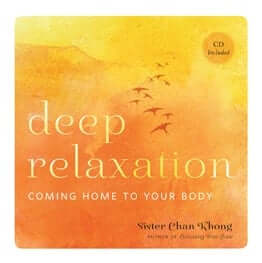
Deep Relaxation
Coming Home to Your Body
By Sister Chan Khong
Parallax Press, 2013
Hardcover, 40 pages, with CD
Reviewed by Gary Gach, True Platform of Light
Whether you are new to our practice or a long-term beginner, you might agree how marvelous is its integration of body, feelings, and mind as one. We start with our bodies, return to our bodies. Even when our minds wander, our bodies are always here, fully present (with a lifetime guarantee on that fact). Our bodies can be wise teachers, messengers of the entire universe. After hundreds of years of their evolution, it’s nice to enjoy a little guidance in their everyday manners of operation.
If you’ve ever enjoyed a retreat with Thay Nhat Hanh and the Plum Village monastics, you’ve already experienced deep relaxation, taught perhaps by a bodhisattva. Yes, I’m watering flowers in Sister Chan Khong’s window garden. How vividly (and bodily) I still remember the greatly pleasurable surprise in first learning deep relaxation from her. How important it is to bring the nonverbal wisdom of our body from the background into the foreground of our awareness. Our body’s generosity to us, immeasurable, ceaseless, and selfless, can be reciprocated with gratitude. How marvelous! And so deeply relaxing, renewing, and refreshing.
That was only my own initial response; you may find it for yourself. It may be one of the most ancient human rituals, visualizing ourselves bodily in a sequence (“toe bone connected to the foot bone,” etc.). Our practice, sometimes known as the body scan, originates with the Buddha. As our Sangha publishing practice group, Parallax Press, offers this precious jewel to the world, it now ripples out like rings of a tree trunk. Don’t you wish all the world could know, enjoy, and share total relaxation? May it be so.
This book with CD makes deep relaxation easily and widely available, like a broad river flowing out to sea. Following an apt introduction by our teacher, the guided meditation is presented in both short and long forms. On the CD, the meditations are read by Sister Chan Khong, Thay, Joseph Emet, Jean-Pierre Maradan, and Sister Doan Nghiem. The CD includes lovely songs sung by Sister Chan Khong in English, French, and Vietnamese.
For a lifetime of mindful living, this provides indispensable training and a beautiful gift. Total relaxation restores us to our organic integrity and our original nature. Recommended for every body.
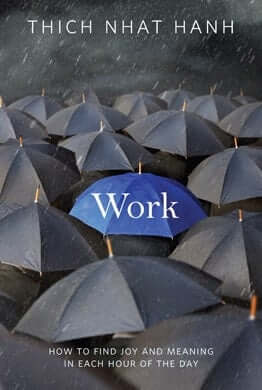
Work
How to Find Joy and Meaning in Each Hour of the Day
By Thich Nhat Hanh
Parallax Press, 2012
Paperback, 120 pages
Reviewed by Natascha Bruckner
As practitioners, we know that mindfulness can happen only in the present moment and that every action can be a meditation. But sometimes, caught up in a busy schedule, we forget. Thay’s new book, Work: How to Find Joy and Meaning in Each Hour of the Day, shows us precisely how each daily activity can be a place to savor our life.
Thay shines a spotlight on all aspects of our day, beginning with waking up in the morning. Rather than hurrying to get up, we can set an intention about how we want to live today. What is our deepest desire? Will it bring nourishment? With each morning routine, we return to mindfulness, guided by the gathas (poems) in this book. Thay reminds us that every action, from brushing our teeth to leaving for work, may be a practice of freedom. “Every time we walk out the door, even if we’re just on the way to our car to go to work, we can take the time to notice that the great Earth bodhisattva is all around us, nourishing and sustaining us.”
Thay’s spotlight penetrates into places where we could practice more wholeheartedly, such as sitting at our desk at work. He asks, “What is the quality of our sitting? … Even if we have a rare moment of quiet at our desks, we talk on the phone or browse the internet. We are workaholics. We always need to be doing something.” Thay invites us to take breaks and sit without effort or purpose, to be happy, like a Buddha.
The book is also a guide for handling strong emotions at work. Thay gives specific instructions for dealing with anger, restoring good communication, and engaging in loving speech and deep listening. The chapter “A New Way of Working” shares alternatives to the culture of competition that is likely to destroy us. Thay presents the three kinds of power that can make us happy: understanding, love, and letting go. The final chapter, “Thirty Ways to Reduce Stress at Work,” offers jewels to help us deepen our joy every day.
Work shows us how to embody the truth that when we live mindfully, every activity of the day—whether answering the phone or cleaning the toilet—can liberate us. Our workday doesn’t need to oppress or restrict us. In fact, our livelihood can become a raft gently floating us to the shore of awakening.
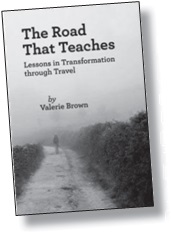
The Road That Teaches
Lessons in Transformation through Travel
By Valerie Brown
Quakerbridge Media of Friends General Congress, 2012
Softcover, 152 pages
Reviewed by Judith Toy, True of Peace
The rambling spirit of this well-organized pilgrim’s primer seems woven into the wind. This travel guide not only provides tips for exploring the sacred world on foot, but also includes tales of exquisite detail and the author’s own personal revelations from the road.
Each chapter contains a small gift in the form of a question to ask ourselves, which may equate to a Quaker query or a Zen koan. At one point, the traveler arrives at a place with two fields: “Two plots, side by side, one wild and one tamed, are much like two competing forces in my life. … How do I acknowledge the wild parts of me, that want to plant garlic in a high desert farm, to Mambo well, and to learn to weave from a Navajo woman? The questions are deeper than the answers.”
Following in Brown’s footsteps, we hear the echo of our teacher— “I have arrived, I am home”—wherever we go. We travel with Brown through the famous El Camino, the enchanted Irish Isle of Iona, the sacred temples of India, Japan’s traditional pilgrimage route through rocks and temples, Shikoku Island, and places closer to home. With each step we are treated to historical nuggets such as the history of Indian Kanchipuram temples, which are dedicated either to Shiva, the destroyer, or to Vishnu, the sustainer of life.
In the introduction, Brown suggests that we “[u]se this book as a prayer book and guide book for contemplation, discernment and reflection.” Her emphasis is on inspiration, whether she is mightily challenged by the weather or rough terrain, or taking a much-needed rest. The end of each chapter contains a practice lesson in mindfulness, and the book even includes a Sample Packing List and Traveler’s Resource Guide. Peppered throughout, like blossoms along the road, are illuminating quotations, like this Spanish proverb introducing the section on afternoon tea in Iona: “How wonderful it is to do nothing, and then rest afterwards.”
